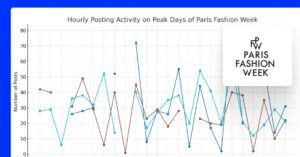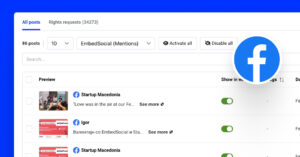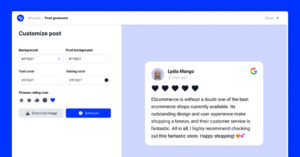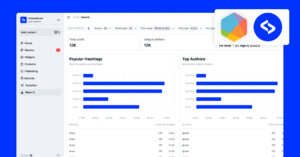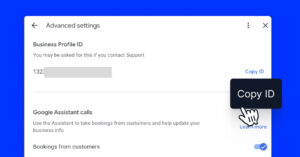Réussir une enquête avec un taux de réponse élevé est vraiment difficile.
La première étape consiste à définir les bonnes questions pour votre enquête.
Dernièrement, cette activité est devenue beaucoup plus facile grâce à l'existence de constructeurs de formulaires tels que EmbedForms qui fournissent Modèles de formulaires gratuits avec des questions prédéfinies pour vous aider à démarrer la création de votre enquête.
Dans cet article, nous allons vous montrer quels types de questions d'enquête vous pouvez poser et une liste préétablie de questions que vous pouvez utiliser dès maintenant.
Alors, sans plus attendre, plongeons dans le vif du sujet.
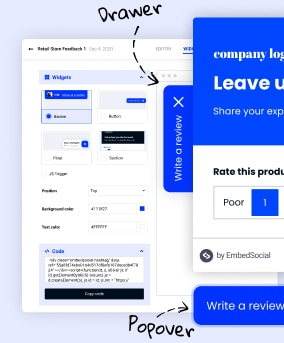
Créez tous vos formulaires web gratuitement
EmbedForms est le seul générateur de formulaires dont vous aurez besoin pour capturer des prospects, créer des enquêtes ou recueillir des commentaires sur votre site web.
Toutes les fonctionnalités PRO peuvent être annulées à tout moment.
Qu'est-ce qui fait une bonne question d'enquête ?
Une bonne question d'enquête doit vous fournir des informations précises et impartiales sur le sujet que vous recherchez.
Pour les propriétaires de petites entreprises, cela signifie que de bonnes questions d'enquête doivent vous donner des réponses claires et véridiques sur l'opinion des clients à l'égard de votre entreprise.
Par exemple, vous pourriez vouloir comprendre ce que les clients pensent de la facilité d'utilisation de votre site web et du prix de votre produit/service, ou peut-être voulez-vous savoir ce qui les empêche d'acheter votre nouveau produit.
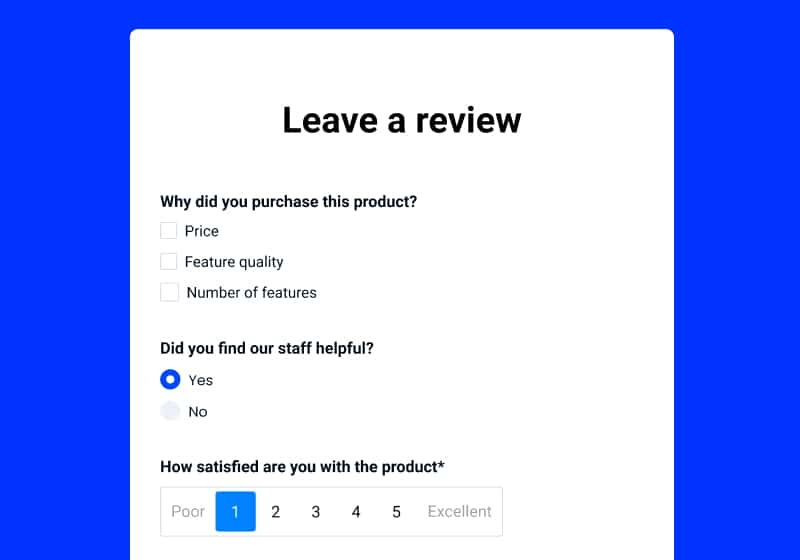
Pour le savoir, vous devez formuler des questions précises qui vous permettront d'obtenir des réponses correctes. Les données de l'enquête vous aideront ensuite à comprendre quels aspects de votre activité doivent être améliorés pour répondre aux besoins de vos clients.
Au minimum, une bonne question d'enquête est clairement formulée et n'incite pas les répondants à donner des réponses incorrectes ou fausses. commentaires des clients.
Combien de questions pour une bonne enquête ?
La réponse à cette question dépend largement de l'objectif de l'enquête. Toutefois, les enquêtes plus courtes ont tendance à avoir un taux de réponse plus élevé car les répondants ont besoin de moins de temps pour les remplir.
En général, les enquêtes de satisfaction de la clientèle ne prennent pas plus de 5 minutes aux personnes interrogées, ce qui signifie qu'elles contiennent une dizaine de questions.
Un objectif bien défini vous aidera à identifier les bonnes questions et à écarter les questions inutiles.
1. Questions ouvertes et questions fermées
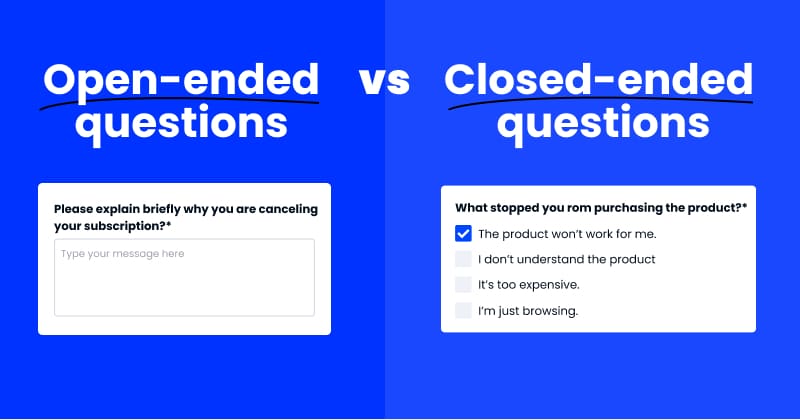
La différence entre les questions fermées et les questions ouvertes réside dans le fait que les personnes interrogées se voient proposer un choix de réponses ou qu'elles sont libres d'écrire ce qu'elles veulent.
Cela dit, les réponses aux questions ouvertes se présentent sous la forme de paragraphes ou de zones de texte, de sorte que les réponses de vos répondants ne sont pas limitées.
En revanche, les questions qui comportent des réponses à l'avance font partie des questions fermées.
Ce type de question se présente sous de multiples formes :
- Questions à choix multiples
- Échelle d'évaluation
- Menu déroulant
- Questions à choix multiples
Lequel utiliser ?
Utilisez des questions fermées lorsque vous souhaitez une enquête rapide et directe.
Comme ces types de questions offrent des réponses à l'avance, il est beaucoup plus facile et rapide de répondre aux enquêtes.
Les questions fermées sont à privilégier si vous souhaitez recueillir des données quantitatives et segmenter les répondants.
Toutefois, il serait utile que vous fassiez preuve de prudence lorsque vous rédigez les réponses. Vous ne devez pas omettre celles qui sont censées être proposées.
Les questions ouvertes offrent au chercheur la possibilité d'obtenir des informations précieuses et uniques.
Vous devriez utiliser des questions ouvertes car elles peuvent vous donner des réponses auxquelles vous ne vous attendiez pas.
C'est important parce que cela vous donne une perspective différente sur la question que vous étudiez.
Néanmoins, ce type de questions comporte un inconvénient.
Il est assez difficile d'analyser et d'interpréter les données qui en découlent.
Néanmoins, si vous souhaitez utiliser ce type de questions ou choisir certaines questions fermées, nous les avons toutes expliquées dans les points suivants.
Cependant, nous recommandons d'utiliser une combinaison des deux groupes pour recueillir des informations pertinentes et précieuses auprès de votre public.
2. Paragraphes
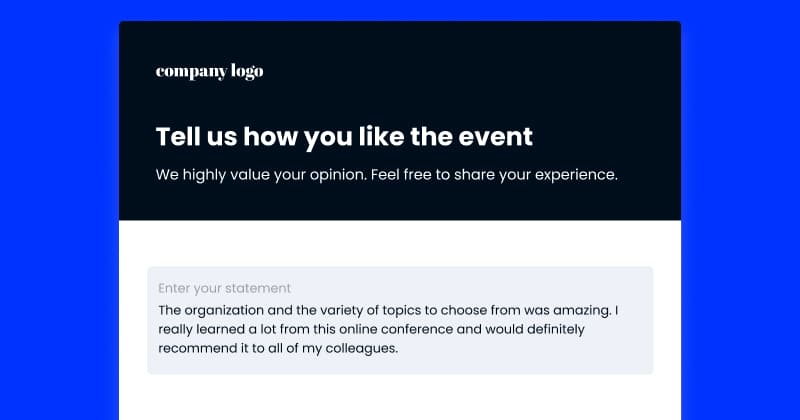
Comme indiqué précédemment, les réponses aux questions ouvertes de l'enquête se présentent sous la forme de paragraphes, de zones de texte, de texte court ou de texte long.
Cela signifie que la plupart des créateurs d'enquêtes en ligne utilisent l'un de ces noms pour marquer l'option des questions ouvertes.
Nous utilisons des questions ouvertes pour donner aux personnes interrogées la liberté d'écrire leurs réponses avec leurs propres mots.
Les questions ouvertes sont utiles lorsque vous souhaitez recueillir un grand nombre d'opinions et d'expériences différentes.
Ils sont parfaits pour accroître la satisfaction des clients lors des enquêtes sur votre entreprise.
D'un autre côté, vous devez être prudent lorsque vous utilisez des questions ouvertes.
Comme elles nécessitent des réponses plus approfondies, il faut également plus de temps pour y répondre. Le taux de réponse peut donc être plus faible.
En outre, vous devez vous attendre à des difficultés lors de l'analyse des résultats de l'enquête. Vous recevrez un grand nombre de réponses différentes qui peuvent être difficiles à interpréter.
3. Questions à choix multiples
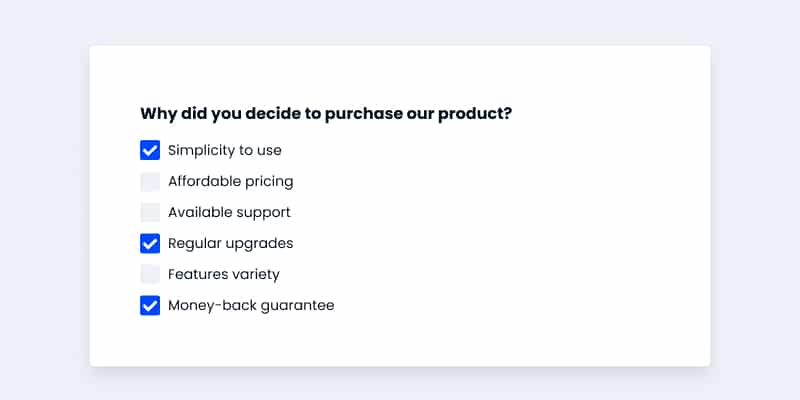
Les questions à choix multiples sont principalement utilisées dans les enquêtes et font partie des questions fermées.
Dans ce type de questions, les personnes interrogées sont invitées à choisir une ou plusieurs réponses que vous avez préalablement énumérées.
Le menu déroulant, les questions dichotomiques (questions oui/non) et les échelles d'évaluation appartiennent tous au groupe des questions à choix multiples.
Ces questions sont simples et précises, et il ne faut pas plus de quelques secondes pour y répondre.
Cela nous amène au premier avantage des questions à choix multiples : elles sont courtes, intuitives et faciles à comprendre.
Et surtout, les réponses à l'enquête sont faciles à analyser.
Les questions à choix multiples se présentent sous plusieurs formes. L'un d'entre eux est le format à réponse unique.
Les réponses sont présentées dans de petits cercles appelés boutons radio, et le répondant doit cliquer sur une seule des options.
Un autre format est celui des cases à cocher, où le répondant est autorisé à sélectionner plus d'une réponse.
Même si les questions à choix multiples sont les plus courantes dans les enquêtes, vous devez garder à l'esprit certains inconvénients.
Il est facile d'y répondre mais complexe de les créer.
Tenez compte du fait que vous devez avoir une connaissance approfondie du sujet que vous explorez afin de proposer des options de réponse qui vous fourniront des données pertinentes.
4. Questions dichotomiques

Les questions dichotomiques sont des questions qui offrent deux réponses opposées. Lorsqu'une question comporte des réponses de type oui/non, accord/désaccord ou vrai/faux, il s'agit d'une question dichotomique.
En voici un exemple :
"Avez-vous trouvé ce que vous cherchiez aujourd'hui ?"(Oui/Non)
"L'équipe d'assistance à la clientèle a-t-elle réussi à résoudre tous les problèmes liés au produit ? (Oui/Non)
Il est plus pratique d'intégrer ces mini-enquêtes ou ces formulaires en tant que widgets de retour d'information sur une page spécifique. Par exemple, vous pouvez mettre en place un formulaire oui/non sur une page d'aide et demander à vos lecteurs :
- "Cela a-t-il répondu à votre question ?"
Et proposez-leur une réponse par oui ou par non.
Il est essentiel d'être prudent avec ce type de questions et de les poser lorsqu'il y a vraiment une marge de manœuvre pour que les répondants puissent décider entre deux extrêmes.
5. Sélecteur de liste déroulante
Le menu déroulant appartient au groupe des questions fermées puisqu'il comporte des options de réponse prédéfinies.
Dans les questionnaires en ligne, les répondants peuvent répondre aux menus déroulants en cliquant sur la flèche vers le bas.
Vous avez probablement rencontré ce type de question lorsque vous avez répondu à des questions démographiques telles que l'âge ou la nationalité.
En fonction de la outil d'enquête, la plupart des menus déroulants sont déroulables lorsqu'on y répond depuis un téléphone, ce qui permet d'y répondre rapidement et facilement.
6. Échelle d'évaluation
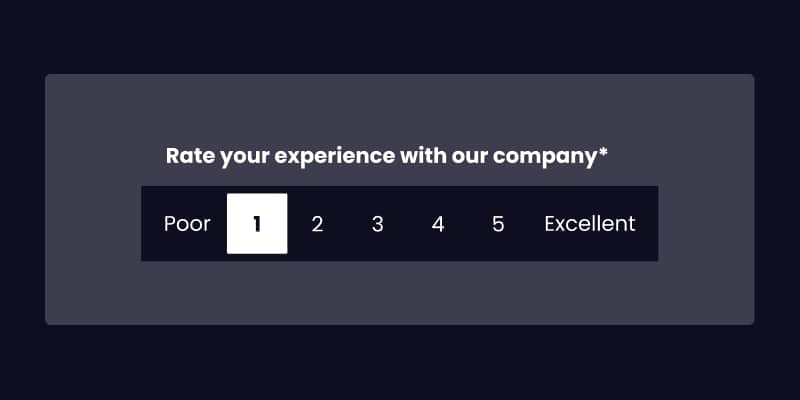
Le NPS (net promoter score) est le meilleur exemple de question à échelle d'évaluation.
Les échelles d'évaluation telles que le NPS sont utilisées pour mesurer la satisfaction et la fidélité des clients.
Dans ce type de questions (parfois appelées questions ordinales), la réponse est présentée sur une échelle de 0 à 10.
Les personnes interrogées choisissent sur l'échelle le chiffre qui décrit le mieux leur réponse.
Il existe plusieurs types d'échelles d'évaluation, comme l'échelle numérique, l'échelle de Likert ou l'échelle d'évaluation par étoiles.
Les échelles d'évaluation sont utilisées à la fois pour les données quantitatives et qualitatives.
L'avantage des échelles d'évaluation est qu'elles sont simples à comprendre et à répondre, et que les données recueillies sont faciles à analyser et à interpréter.
D'autre part, les données que vous recevrez sont limitées. Vous obtenez la note, mais il n'y a pas d'informations sur la raison de cette note.
Démarrer avec NPS
7. Questions à échelle de Likert

Questions à échelle de Likert sont l'une des questions de classement les plus populaires utilisées pour mesurer le niveau d'accord, la fréquence, la qualité ou l'importance d'un produit ou d'un service.
Les questions à échelle de Likert peuvent prendre la forme d'une déclaration, par exemple :
"Le site web est facile à utiliser et à comprendre.
Les répondants se voient ensuite attribuer une échelle de réponses allant de "tout à fait d'accord" à "pas du tout d'accord".
Les chercheurs peuvent également poser des questions de Likert sous la forme d'une question, par exemple :
"Quelle est la probabilité que vous achetiez à nouveau chez nous ?
Les répondants peuvent à nouveau choisir une réponse sur l'échelle de points qui va de très probable à très improbable.
8. Questions sur le téléchargement d'images
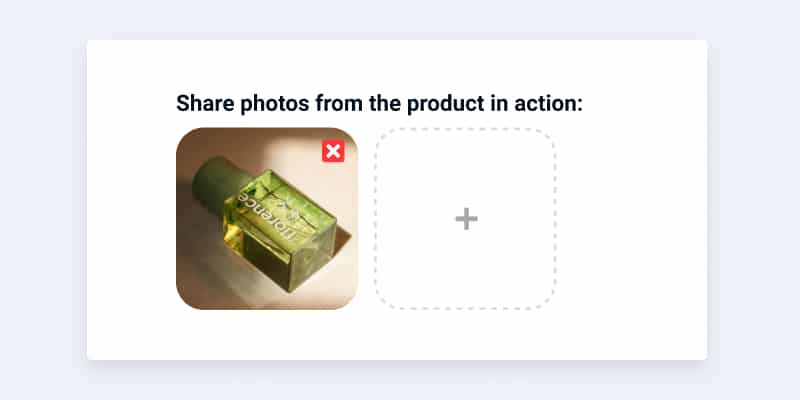
Les questions de téléchargement d'images permettent aux personnes interrogées de télécharger une image dans votre enquête.
C'est un excellent moyen de montrer preuve sociale aux clients en ligne.
De plus, l'expérience client est meilleure lorsque les utilisateurs peuvent voir l'image réaliste de votre produit.
En outre, vous obtenez des informations sur la manière dont vos clients utilisent le produit.
Les avantages de l'utilisation de questions avec téléchargement d'images dans votre enquête sont d'ajouter de la crédibilité et de faire gagner du temps à vos répondants en leur faisant perdre du temps à écrire de longues réponses.
Exemples de questions d'enquête
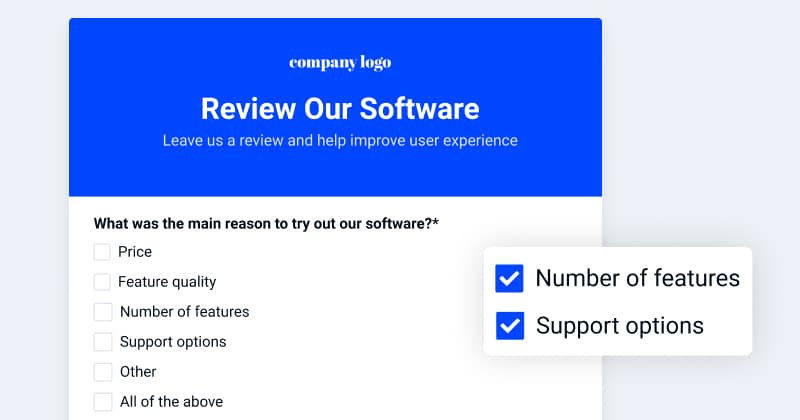
Le choix des questions à utiliser dépend principalement de l'objet de la recherche. En d'autres termes, de l'objectif que vous souhaitez atteindre avec l'enquête.
Bien entendu, les questions dépendent également de la nature de l'entreprise elle-même.
Cependant, ci-dessous, nous avons fait une liste d'exemples de questions d'enquête que vous pouvez inclure dans n'importe quelle enquête.
Exemples de questions ouvertes
- Pouvons-nous faire quelque chose pour améliorer votre expérience avec nous ?
- Qu'est-ce qui vous a empêché de finaliser votre achat aujourd'hui ?
- Y a-t-il des informations manquantes sur notre site web ?
- Quelles autres informations souhaiteriez-vous voir figurer sur cette page ?
- Quels sont les autres produits que vous aimeriez nous voir proposer ?
Exemples de questions à choix multiples
- Comment avez-vous entendu parler de nous ?
- Pourquoi nous avoir choisis ?
- Avez-vous trouvé suffisamment de détails sur le produit ?
- Quelles sont les fonctionnalités que vous utilisez le plus ?
- Combien de fois avez-vous fait appel à nos services ?
Exemples de questions dichotomiques
- Avez-vous trouvé ce que vous cherchiez ?
- Avez-vous reçu votre produit à temps ?
- Achèteriez-vous à nouveau quelque chose chez nous ?
- Allez-vous acheter à nouveau l'un de nos produits ?
- Le personnel vous a-t-il semblé accueillant et sympathique ?
Exemples de questions sur les échelles d'évaluation
- Sur une échelle de 1 à 10, quelle note donneriez-vous à notre service clientèle ?
- Sur une échelle de 1 à 10, comment évaluez-vous la qualité du produit ?
- Comment évaluez-vous le rapport qualité-prix du produit ?
- Sur une échelle de 1 à 10, comment évaluez-vous notre temps de réponse ?
- Nous recommanderiez-vous à un ami ou à un collègue ?
Exemples de questions à échelle de Likert
- Dans quelle mesure vous êtes-vous senti en sécurité lorsque vous avez communiqué les détails de votre carte ?
- Quelle est la probabilité que vous achetiez à nouveau quelque chose chez nous ?
- Dans quelle mesure êtes-vous satisfait du service et de l'approche du personnel ?
- Quelle est la fréquence de vos achats dans notre magasin ?
- Comment évaluez-vous la qualité du produit ?
Conseils pour rédiger de bonnes questions d'enquête
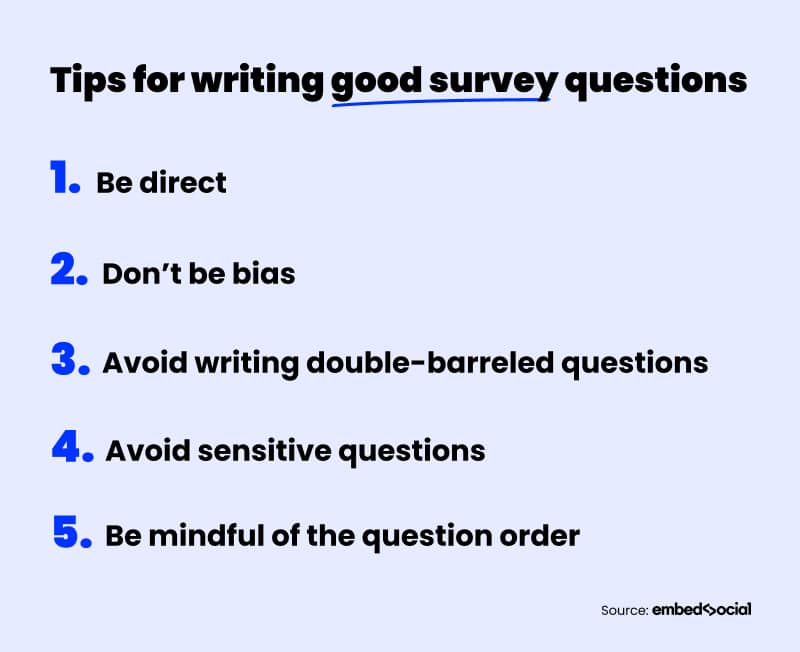
Dans le monde moderne d'aujourd'hui, il suffit d'un clic pour obtenir des modèles d'enquête contenant différentes questions en rapport avec votre sujet.
Il n'est pas nécessaire d'investir votre temps dans la création d'une enquête à partir de zéro, alors que vous pouvez obtenir une enquête professionnelle en quelques minutes grâce à EmbedForms.
Toutefois, si vous êtes toujours curieux de savoir comment rédiger des questions d'enquête efficaces, voici trois étapes simples à suivre :
- Soyez direct. Utiliser des expressions claires et compréhensibles par tous.
- Ne soyez pas partial. Évitez de rédiger des questions qui amènent le répondant à une réponse particulière. Essayez d'élaborer des questions aussi précises que possible.
- Évitez de rédiger des questions à double tranchant. Ne posez qu'une seule question pour éviter toute confusion.
- Questions sensibles. Gardez à l'esprit que certaines questions telles que la vie personnelle, la religion, etc. peuvent être considérées comme sensibles. Les personnes interrogées peuvent ne pas répondre à ces questions ou y répondre de manière mensongère.
- Faites attention à l'ordre des questions. Cela peut paraître simple, mais on peut facilement s'y tromper. Un ordre logique des questions signifie que l'on pose les questions les plus importantes au début et les moins importantes à la fin.
FAQ pour rédiger les meilleures questions d'enquête
Une question d'enquête qui oblige les répondants à choisir parmi un ensemble fixe d'options s'appelle une question fermée. Ce type de question d'enquête peut être avantageux parce qu'il.. :
Permet de collecter des données qui peuvent être facilement analysées et comparées.
Réduit les risques d'ambiguïté ou d'interprétation erronée
Peut permettre de s'assurer que tous les répondants ont des réponses unifiées
Voici un exemple de question ouverte : "Que pensez-vous de la nouvelle politique de l'entreprise ?" Ce type de question permet aux personnes interrogées de répondre avec leurs propres mots, ce qui peut fournir des informations précieuses que les questions fermées ne permettent pas d'obtenir.
Lors de la rédaction des questions d'enquête, il est important d'éviter les biais et les ambiguïtés, d'être compréhensible pour la personne qui répond et de pouvoir répondre facilement à la question. Une bonne question d'enquête est concise, claire et facile à répondre.
Une question d'enquête suggestive est une question qui suggère une réponse particulière. Par exemple, une question d'enquête demandant "N'êtes-vous pas d'accord pour dire que cette nouvelle politique de l'entreprise est géniale ?" conduit à une réponse OUI.
Une question d'enquête à double entrée est une question qui pose deux questions en une, ou dans laquelle la réponse à une partie de la question affecte la réponse à l'autre partie. Par exemple, une question d'enquête qui demande "Aimez-vous notre nouvelle politique d'entreprise et pensez-vous qu'elle est géniale ?
Une question d'enquête tendancieuse est une question qui utilise un langage tendancieux pour influencer la réponse du répondant. Par exemple, une question d'enquête qui demande "Ne pensez-vous pas que cette nouvelle politique de l'entreprise est terrible ?" est chargée d'une réponse NON.
Une question d'enquête peut être biaisée par sa formulation, son ton ou la manière dont elle est posée. Par exemple, une question d'enquête qui demande "À quelle fréquence trouvez-vous que les produits de notre entreprise sont satisfaisants ?" est biaisée en faveur d'une réponse positive.
Cela dépend du type d'enquête et de son objectif. Une enquête peut comporter une seule question ou plus de 100 questions.
Une question d'enquête peut être trop vague si elle ne fournit pas suffisamment d'informations pour que le répondant puisse y répondre. Par exemple, une question d'enquête demandant "Comment allez-vous aujourd'hui ?" est trop vague.
Pour que les questions de votre enquête soient claires et concises, utilisez un langage simple et évitez le jargon. Veillez également à relire vos questions avant d'envoyer l'enquête.
Les questions d'enquête commencent généralement par un mot tel que "Quoi", "Comment" ou "Pourquoi". Par exemple, une question d'enquête pourrait être : "Quelle est votre couleur préférée ?".
Les questions d'enquête les plus courantes sont les suivantes :
À quelle fréquence faites-vous X ?
Quelle est votre opinion sur X ?
Recommanderiez-vous X à un ami ?
Avez-vous trouvé X facile ou difficile à utiliser ?
Qu'avez-vous pensé de X ?
Principaux enseignements
Nous avons passé en revue différents types de questions d'enquête et nous avons constaté que chacun d'entre eux présente des avantages et des inconvénients.
Le plus important, lorsqu'on choisit un type de question d'enquête, est de savoir quand l'utiliser et dans quel but.
Une fois que vous aurez appris la meilleure application pour chacune de ces questions, vous obtiendrez d'excellents résultats en les mettant en pratique.
Et le meilleur, en utilisant des des modèles pour créer des formulaires est un moyen rapide de commencer à construire votre prochain formulaire d'enquête.

Créez tous vos formulaires web gratuitement
EmbedForms est le seul générateur de formulaires dont vous aurez besoin pour capturer des prospects, créer des enquêtes ou recueillir des commentaires sur votre site web.
Toutes les fonctionnalités PRO peuvent être annulées à tout moment.


